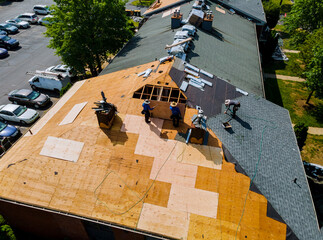If you want to make some changes to your home, one of the things that you should consider is installing new roofing. The roofing material you use can have a major impact on how it looks and how well it performs. You also need to be aware of the type of underlayment you will need for your roof and what kind of shingles you will want.

Roofing plays a critical role in the construction of a building. It’s an important part of the structure and will make the quality of construction questionable if it needs to be done correctly. So if you’re looking to buy a house, it might be time to update your roof. A trustworthy Roofer can ensure that your building’s roof doesn’t leak and is of high quality while complementing the aesthetics of your structure.
Insulating your roof is a relatively easy and cost-effective way to enhance your home’s energy efficiency. It also helps to prevent thermal leakage, thereby lowering your energy bill. However, before you start, there are a few tips to keep in mind.
Choosing the best material is vital to ensure you don’t end up with an expensive roof insulation mess. If you’re not sure which insulation product is right for you, get a free quote from an insulation expert.
There are two main types of roof insulation. You can install insulation inside your roof or outside. This will depend on the type of building you have. For instance, a new build house will probably have it built in.
The roofing shingles we use today have become an integral part of the way we build our homes. These flat, rectangular pieces of roofing material are used to create a waterproof barrier that repels water, ice and snow. Roof shingles are available in various styles, colors and materials. Depending on your type, they can last as long as 25 years.
Asphalt shingles are the most common type of shingle. They are naturally fire resistant, but not as effective against storms and other severe weather events. However, they are durable, and can last up to 30 years if properly maintained. There are several different types of shingles, including dimensional, 3-tab and luxury. Each style offers a distinctive aesthetic and functional benefits.
Roof sheathing is the secondary layer of material that protects the exterior of your home from damage caused by the elements. Depending on your needs, you can purchase different types of sheathing.
The two main types of sheathing are plywood and OSB. These materials are both popular for roofing, but they have their pros and cons. For instance, plywood is easier to install but not waterproof. It is also heavier than OSB.
Unlike plywood, OSB has many layers of wood chips. During construction, these chips are bonded together using an adhesive. Compared to plywood, it is more durable but is also more expensive.
Another factor to consider when determining the thickness of your roof sheathing is the snow load. You should always allow for extra width on your roof.
The underlayment is a vital part of your roof. It adds a secondary layer of protection from the elements and helps to prevent water penetration. There are many different underlayments to choose from, so it’s important to understand which ones are best for your roof.
The best underlayment for you will depend on the weather in your area. If you live in a colder climate, choose an underlayment that can handle ice and snow. It would be best if you also looked for one with a peel-and-stick technology. This will make it easier to install.
In milder climates, felt is the preferred underlayment. It is more durable and lightweight, and offers excellent tear resistance. However, it is heavier and can wrinkle when exposed to colder temperatures.
Ice dams can be a serious hazard to your home. They can lead to water backing up in your attic and other interior areas. This can cause extensive damage to your walls, ceilings and gutters. Fortunately, there are steps you can take to minimize their effects.
One is to install a waterproof underlayment. A waterproof underlayment is a layer of roofing material across the top of your roof, before your shingles are installed. Waterproof underlayment helps to prevent leaks, especially in cold climates.
Another is to make sure your attic is properly insulated. Properly insulated attics reduce the likelihood of ice dams. In addition, well-ventilated attics help to lower the temperature of your attic, which helps to inhibit thaw/refreeze cycles.
